Are we paying attention?
ProPublica updated this report from September, 2020. I missed it the first time published, and now already seeing population shifts in the Mountain West, specifically, the Wood River Valley in South-Central Idaho. -dayle
This article, the second in a series on global migration caused by climate change, is a result of a partnership between ProPublica and The New York Times Magazine, with support from the Pulitzer Center.
Senior citizens at a cooling center in Phoenix [summer 2020] during Arizona’s record-setting heat wave. (Meridith Kohut for The New York Times)
Climate Change Will Force a New American Migration
“Wildfires rage in the West. Hurricanes batter the East. Droughts and floods wreak damage throughout the nation. Life has become increasingly untenable in the hardest-hit areas, but if the people there move, where will everyone go?
The millions of people moving north will mostly head to the cities of the Northeast and Northwest, which will see their populations grow by roughly 10%, according to one model. Once-chilly places like Minnesota and Michigan and Vermont will become more temperate, verdant and inviting. Vast regions will prosper; just as Hsiang’s research forecast that Southern counties could see a tenth of their economy dry up, he projects that others as far as North Dakota and Minnesota will enjoy a corresponding expansion. Cities like Detroit; Rochester, New York; Buffalo and Milwaukee will see a renaissance, with their excess capacity in infrastructure, water supplies and highways once again put to good use. One day, it’s possible that a high-speed rail line could race across the Dakotas, through Idaho’s up-and-coming wine country and the country’s new breadbasket along the Canadian border, to the megalopolis of Seattle, which by then has nearly merged with Vancouver to its north.”
Sun Valley’s Population Explodes During Pandemic Year
Eye on Sun Valley
|
https://eyeonsunvalley.com/Mobile/Mobile_Story_Reader?StoryId=8355
Idaho Mountain Express
by Greg Foley
Sun Valley tourism is rebounding, marketing group says
Report: Some 1,500 people have moved to valley during pandemic
The Sun Valley area is undergoing an unexpected surge in growth amid the COVID-19 pandemic, changing life for locals and—to some degree—how Idaho’s premier tourist destination is marketed to potential visitors.
That was the overarching message of a semi-annual meeting conducted by the Visit Sun Valley marketing and business organization livestreamed to viewers Wednesday from The Community Library in Ketchum.
Many people coming to the area are “COVID evacuees,” remote workers, adventurers and people who own second—or third—homes in the area, he said. Amid the pandemic, Visit Sun Valley has had to consider that visitors are booking trips later, staying longer and have been looking for things to do, as many events were canceled, he said. Group visits were down, hotel bookings were down and there have been fewer “traditional” vacations of families flying in for a week-long visit. Instead, more people have been driving to the Wood River Valley from places such as Salt Lake City, Boise and Twin Falls, he said.
“It just hasn’t been the same as it was historically,” Fortner said.
The organization sees a “pent-up demand” for travel, the return of many popular events, increased confidence in the safety of travel, a strong interest in mountain communities and strong commercial air service to the region all as encouraging factors for the tourism sector, Fortner said. In addition, many people are conducting internet searches for Sun Valley, he noted.
As the organization moves into a new phase of its “Mindfulness in the Mountains” marketing campaign, it is encouraging community “stewardship” from visitors—people who are a “better visitor that is enlightened and informed,” the organization’s presentation stated.
In addition, Visit Sun Valley is promoting a wide range of “guided experiences”—including cooking classes, yoga, fly fishing and mountain biking—that educate visitors, get them outdoors and allow them to gain a “deeper sense of what Sun Valley is all about,” said Marketing Director Ray Gadd. Visit Sun Valley is also promoting the return of signature events, including the Sun Valley Music Festival, the Sun Valley Writers’ Conference and the Trailing of the Sheep Festival, Gadd said.
During the meeting, David Patrie, outreach director for the Sun Valley Economic Development business organization, presented data from an in-depth analysis of the effects of the pandemic and an influx of new residents into the Wood River Valley over the past year.
“Last March, we never would have predicted where we are today,” Patrie said.
New voter registrations in Blaine County increased from 1,640 in 2016 to 3,770 in 2020, Patrie said, with most registrants in the 22-35 age range.
“Yeah, it’s a lot,” he said, “and it feels like a lot.”
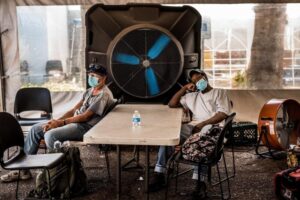
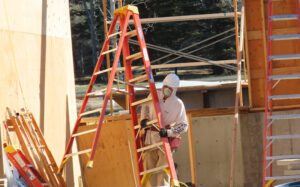
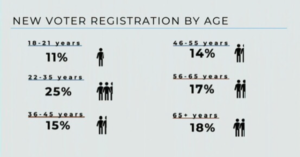
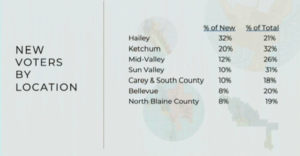
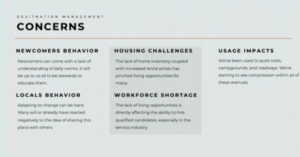
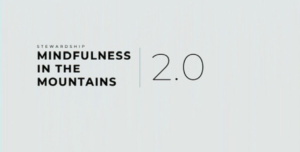
Leave a Reply